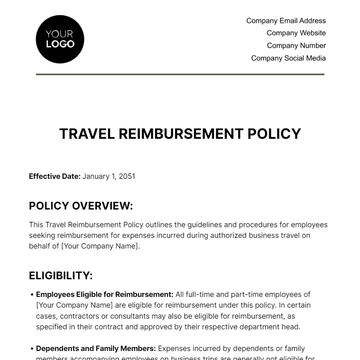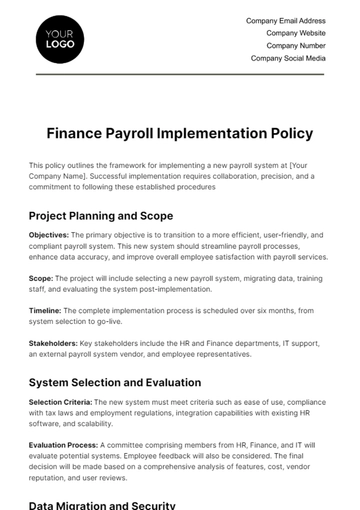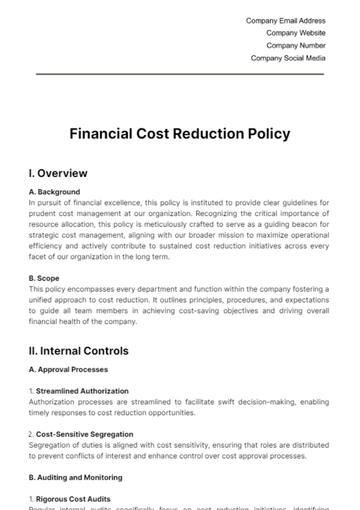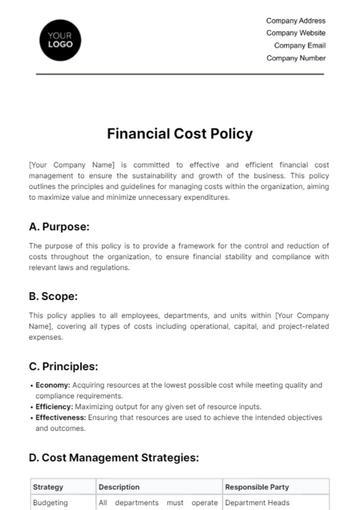Free Finance Payment Policy Outline
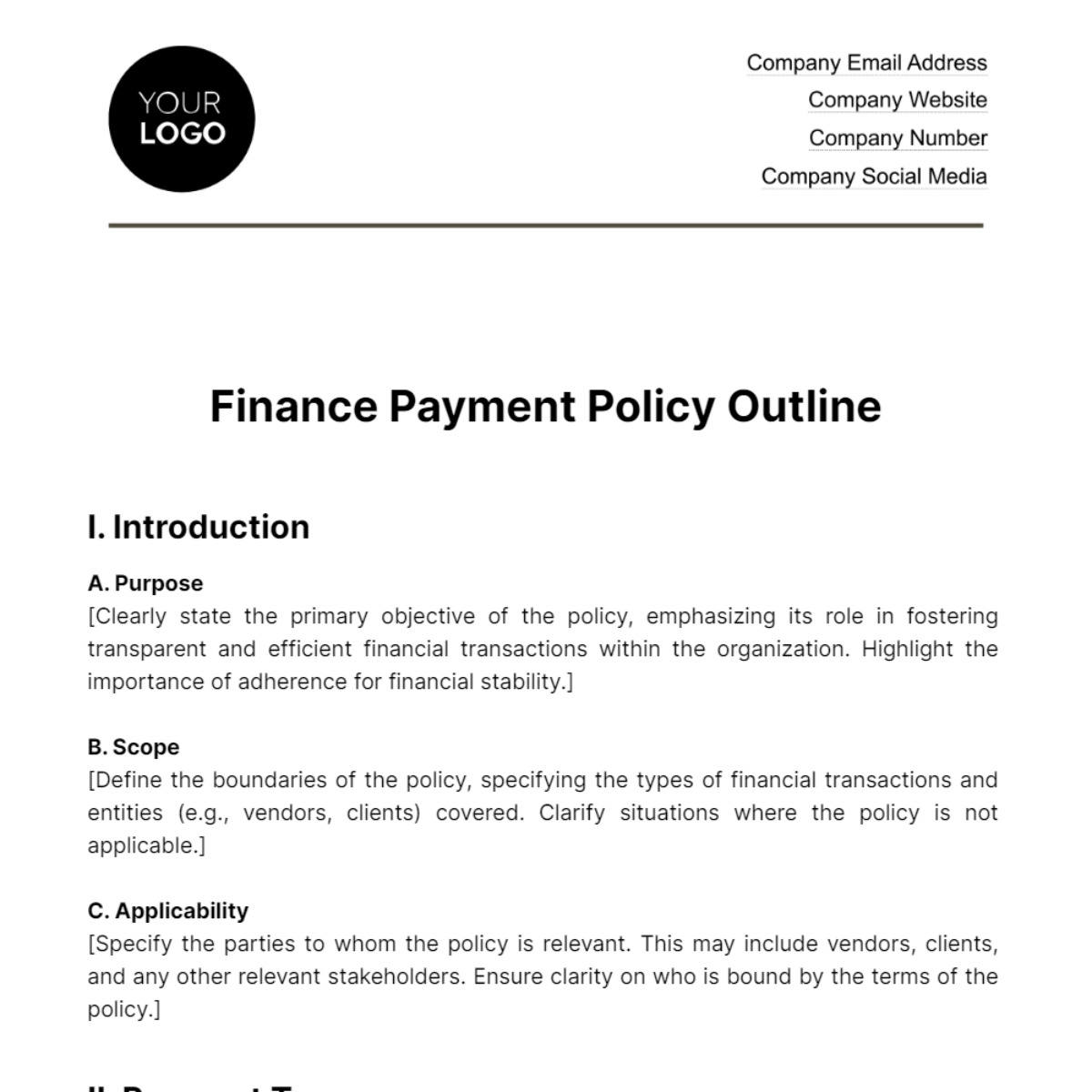
I. Introduction
A. Purpose
[Clearly state the primary objective of the policy, emphasizing its role in fostering transparent and efficient financial transactions within the organization. Highlight the importance of adherence for financial stability.]
B. Scope
[Define the boundaries of the policy, specifying the types of financial transactions and entities (e.g., vendors, clients) covered. Clarify situations where the policy is not applicable.]
C. Applicability
[Specify the parties to whom the policy is relevant. This may include vendors, clients, and any other relevant stakeholders. Ensure clarity on who is bound by the terms of the policy.]
II. Payment Terms
A. Invoice Submission
Acceptable Formats
[Outline the permitted formats for submitting invoices, including electronic formats (e.g., PDF, electronic invoicing systems) and physical formats.]
Required Information
[Specify the mandatory details that invoices must include, such as invoice number, date, itemized charges, and any other essential information for accurate processing.]
B. Due Dates
Standard Payment Terms
[Define the default time frame for payments, indicating the standard period within which payments are expected.]
Customized Terms (if applicable)
[Describe any variations in payment terms based on specific agreements, such as negotiated longer payment periods for certain clients.]
C. Early Payment Discounts
Criteria for Eligibility
[Clearly state the conditions for qualifying for early payment discounts, specifying factors such as payment timing and any specific requirements.]
Discount Percentage
[Specify the percentage or amount of discount offered for early payments, providing a clear incentive for prompt settlements.]
III. Payment Methods
A. Accepted Forms of Payment
[Enumerate the types of payments the organization accepts, including electronic transfers, checks, and any other approved methods. Ensure that stakeholders are aware of the accepted payment channels.]
B. Electronic Funds Transfer (EFT)
Bank Account Details
[Provide information on the bank accounts to which electronic transfers should be made, ensuring accuracy and preventing errors in transactions.]
Process and Security Measures
[Detail the steps involved in EFT transactions, including any security measures in place to protect sensitive financial information.]
C. Check Payments
Mailing Address
[State the address to which checks should be mailed, ensuring that physical payments are directed to the correct location.]
Processing Timeframes
[Specify the expected processing time for check payments, managing expectations for both the payer and payee.]
IV. Late Payments
A. Grace Period
[Define any grace period provided for late payments, specifying the additional time granted before penalties are applied.]
B. Late Fees
Calculation Method
[Clearly explain how late fees are calculated, detailing whether they are flat fees or a percentage of the outstanding amount.]
Tiered Structure (if applicable)
[If applicable, outline a tiered structure for late fees based on the severity or duration of the payment delay.]
C. Communication Protocol for Late Payments
[Specify the communication process for addressing late payments, including notifications and reminders. Provide clear instructions on how to address late payments.]
V. Credit Terms
A. Credit Application Process
Documentation Requirements
[List the required documents for applying for credit, ensuring a comprehensive assessment of creditworthiness.]
Approval Criteria
[Define the criteria used to assess and approve credit applications, including factors such as financial stability and payment history.]
B. Credit Limits
[Specify the maximum credit amount extended to clients, providing a clear cap to manage financial risk.]
C. Periodic Credit Reviews
[Explain the procedures for periodic reviews of credit terms, detailing how and when credit assessments will be conducted.]
VI. Compliance and Regulations
A. Relevant Financial Regulations
Overview
[Provide an overview of pertinent financial regulations impacting payment processes, highlighting the organization's commitment to compliance.]
Implications for Payment Processes
[Explain how specific financial regulations affect payment processes, ensuring alignment with legal requirements.]
B. Internal Compliance Measures
Auditing Procedures
[Describe internal auditing processes related to payments, outlining how the organization ensures compliance and accuracy.]
Policy Updates
[Outline procedures for updating the policy in response to changes in regulations or internal requirements.]
VII. Dispute Resolution
A. Submission of Dispute
[Clarify how disputes should be submitted, detailing the required information and the process for initiating dispute resolution.]
B. Investigation and Resolution
[Explain the steps involved in investigating and resolving disputes, ensuring a fair and transparent resolution process.]
VIII. Policy Review and Updates
A. Periodic Review Schedule
[Specify the frequency of reviews for the policy, ensuring that the policy remains current and effective.]
B. Criteria for Policy Updates
[Describe the criteria that trigger updates to the policy, including changes in regulations, industry standards, or organizational needs.]
C. Communication of Changes
[Explain how updates to the policy will be communicated to stakeholders, ensuring transparency and awareness of any modifications.]
IX. Conclusion
[Provide a concise summary of the key points in the policy, emphasizing its significance in maintaining financial integrity and encouraging stakeholders' compliance.]
- 100% Customizable, free editor
- Access 1 Million+ Templates, photo’s & graphics
- Download or share as a template
- Click and replace photos, graphics, text, backgrounds
- Resize, crop, AI write & more
- Access advanced editor
Level up your financial strategy effortlessly with our editable Finance Payment Policy Outline Template, exclusive on Template.net! This dynamic tool, with its customizable features and AI Editor Tool, ensures precision in articulating payment policies. Streamline your approach, empowering your team to navigate financial landscapes with newfound ease and clarity immediately!
You may also like
- HR Policy
- Restaurant Policy
- Company Policy
- Accounting Policies and Procedures
- Website Policy
- Privacy Policy
- Safety Policy
- School Policy
- IT and Software Policy
- Law Firm Policy
- Construction Policy
- Interior Design Policy
- Travel Agency Policy
- Education Academic Policy
- Security Policy
- Real Estate Policy
- Expense Policy
- Software Policy





